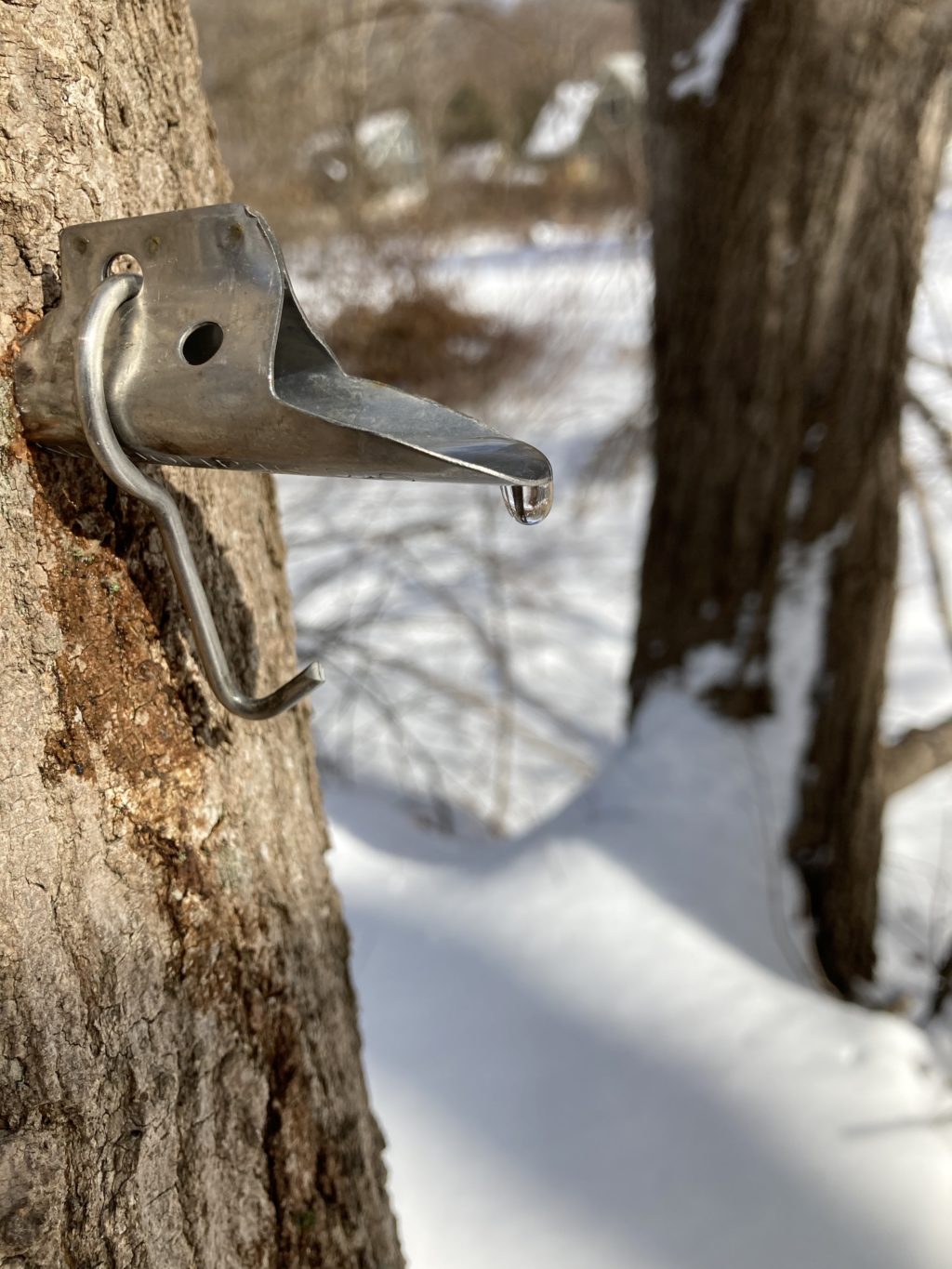Almanac: The Sweet Sign Of Spring

Maple sap tap. Photo: Stephen Braun
Editor’s note: This column first appeared in the Indy on February 26, 2021. Because sugaring season is well underway, we thought our readers might enjoy revisiting Stephen Braun’s report.
Last Saturday afternoon was sunny but the air felt cold, so I did not expect much as I set the tip of an auger against the rough bark of a sugar maple. After only a dozen cranks on the bit-and-brace, however, I could see that the wood chips being expelled from the hole were moist. Another dozen cranks and the wood became more like a paste, and when I withdrew the bit from the hole, a small rivulet of clear sap ran out. I quickly cleared the hole of debris, set the tap with a few light whacks of a hammer, and hung a galvanized steel bucket.
There are many audible signs of spring, most notably the sudden appearance of mating calls among birds and, later in spring, the exuberant choruses of spring peepers rising from swampy areas. But, for me, the rhythmic plink, plink, plink of sap falling into a tin bucket is the most pleasant vernal music. Perhaps it’s because it comes so early, with snow usually still thick on the ground and the land looking so decidedly wintry. That tin-bucket tympany, though, proves that life is starting to throb despite appearances.
The tapping started a little late this year — Valentine’s Day is the traditional start around here. But it was too cold and snowy that week, so myself and the other members of the Maple Mob — a group organized by North Amherst resident Wayne Crouch — waited until the forecast called for temperatures above freezing by day, below freezing at night. That cycle is required for maple sap to flow, though the details of how the cycle works is still being worked out by plant biologists.
The broad picture is known — and it’s counter-intuitive. For most trees, sap rises from roots to branches under the influence of “root pressure.” In sugar maples, the flow is bi-directional and, when it’s running from one of our taps, it’s actually coming from the branches down toward the roots. In sugar maples, a below-freezing night causes sap to be pulled upward from the roots into the branches. And this is where things get complicated. Water expands when it freezes, so you would think that the sap in all those freezing branches would be pushed back down into the roots rather than, somehow, pulling more sap up from below. How this happens apparently involves trapped carbon dioxide in the cells of the branches, the unusually high sugar content of the sap (usually between 2 and 4 percent), and the way sap freezes on the insides of the water-bearing cells (if you’re curious, you can find more information here).
The basic idea, though, is that the freeze-thaw cycles act like a pump, alternately forcing sap up a sugar maple and back down. The challenge for those of us maniacal enough to try to catch some of that vacillating sap in tin buckets is to predict when the sap will actually flow. (We are a small group and only set about 120 taps, so we still use buckets rather than plastic tubing, which, although efficient once set up, involves a different set of challenges and effort and isn’t as aesthetically pleasing.)
I’ve been sugaring for more than 15 years and I’ve given up trying to predict sap flow. Yes, in general, if you’ve had a below-freezing night and the daytime temperature is 40 or above and it’s sunny and calm, you’re likely to get sap flow. But sap will confound you…flowing when you least expect it, stubbornly reluctant when you think it should gush.
The sap was certainly gushing last Saturday. Nearly every hole I drilled was juicy, setting up an allegro melody of fast-dripping of sap into dozens of pails. This afternoon I’ll go over and see if there’s enough to collect. If so, we should get at least 50 gallons of sap. We usually wait until we have at least 100 gallons of sap on hand before we fire up our Rube Goldberg evaporator. You have to boil about 40 gallons of sap to get a gallon of syrup and we need to keep at least 2 gallons of syrup in our evaporator pan to control the boil. Letting the level get too low risks a spectacular boil-over and the conversion of beautiful golden syrup to an awful (and awful to clean) black sludge.
In ordinary times we invite anybody interested in some hard work to come lend a hand with all the various aspects of sugaring. But given the pandemic, we are limiting participation this year. That’s a shame, because one of the best things about sugaring is working and hanging out with similarly-demented friends. Ah well…next sugar season! But you don’t need a lot of fancy equipment to make syrup. If you’re interested in trying your own hand at some backyard sugarin’ there are some helpful resources here, here, and here.
Almanac is a regular Indy column of observations, musings, and occasional harangues related to the woods, waters, mountains, and skies of the Pioneer Valley. Please feel free to comment on posts and add your own experiences or observations.

1 thought on “Almanac: The Sweet Sign Of Spring”